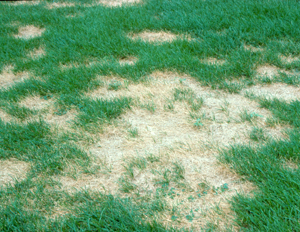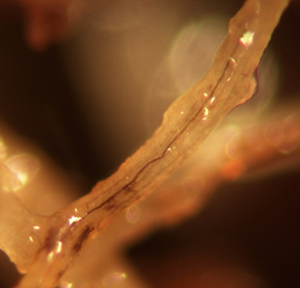G1913
Necrotic Ring Spot and Summer Patch Diseases in Turfgrass
Causes, symptoms and management of necrotic ring spot in turfgrass. This is one in a series of NebGuides on managing turfgrass diseases.
Loren J. Giesler Extension Plant Pathologist
|
Necrotic ring spot and summer patch can develop in highly stressed areas of turf. There are many effective ways to manage necrotic ring spot and summer patch, primarily through cultural practices that enhance turf health. Fungicides also are available to control these diseases; however, they should only be considered if other practices fail. The following information describes the diseases and how to identify and manage them.
Cause, Hosts and Occurrence
Necrotic Ring Spot
Cause: Ophiosphaerella korrae
Primary hosts: Kentucky bluegrass
Occurrence: May – June
Summer Patch
Cause: Magnaporthe poae
Primary hosts: Kentucky bluegrass, Annual bluegrass, Fine fescues
Occurrence: July – September
Key Symptoms
- Circular patches of dead turf with a healthy tuft of grass in the center (Figure 1).
- Symptoms typically are observed in full sun exposure areas in the landscape. Also observed in high-stress areas near sidewalks and driveways.
- Brown to black roots (Figure 2).
Cultural/Maintenance Practices
- May 1-15:
- Aerate soil to improve conditions and reduce thatch.
- Aerate soil to improve conditions and reduce thatch.
- June – October:
- Maintain good fertility program.
- Avoid excessive irrigation or drought stress.
- Use light, frequent irrigation during dry periods to reduce heat stress and maintain moisture in the root profile.
- Raise mowing height in July and August.
- August:
- Aerate in late August and then overseed with a mixture of perennial ryegrass and an improved Kentucky bluegrass blend or renovate the turf area and seed with tall fescue.
Fungicide Program
- Necrotic Ring Spot:
- April 15-30: Apply fungicide to areas with a history of necrotic ring spot.
- May 15-30: Repeat the fungicide application 30 days after the first application (Table I).
Fungicides for necrotic ring spot are presented in Table I. Product examples are provided for each active ingredient, but not all products are listed. Homeowner and commercial product labels will list active ingredients. While the active ingredient may be in combination with others, users should look for a specific active ingredient with or without other chemistry modes of action.
| Table I. Fungicides for Necrotic Ring spot Control in Turf1 | ||||
| Fungicide | Fungicide Class | Application Interval (days) |
Efficacy2 |
Product Names |
| azoxystrobin | Strobilurin | 14-28 |
L |
Heritage |
| fenarimol | DMI4 | 1-2x |
3 |
Rubigan |
| iprodione | Dicarboximide | 14-21 |
2 |
Chipco 26019 |
| myclobutanil | DMI | 28 |
3 |
Eagle |
| propiconazole | DMI | 28 |
2 |
Banner MAXX3 |
| thiophanate-methyl | MBC4 | 10-14 |
2 |
Cleary’s 33363 |
| 1Fungicide active ingredients, class and efficacy ratings for products labeled for the control of necrotic ring spot. Table adapted from: P. Vincelli and A.J. Powell, Chemical Control of Turfgrass Diseases 2008, University of Kentucky Cooperative Extension Service. 2Rating system: 4 = Excellent control; 3 = good to excellent control; 2 = fair to good control; 1 = control is inconsistent but good in some instances; L = limited data. 3Other products with the same active ingredient may be available. 4DMI = DeMethylation Inhibitors (Triazole fungicides); MBC = Methyl Benzimidazole Carbamate. |
||||
Summer Patch:
- May:
- Begin preventive fungicide treatments when soil temperature at a 2-inch depth in mid afternoon reaches 65°oF for 5 consecutive days.
- Begin preventive fungicide treatments when soil temperature at a 2-inch depth in mid afternoon reaches 65°oF for 5 consecutive days.
- June:
- Repeat the fungicide application 30 days after the first application.
For curative fungicide treatments during the growing season, use propiconazole or azoxystrobin (Table II).
Fungicides for summer patch management are presented in Table II. Product examples are provided for each active ingredient, but not all products are listed. Homeowner and commercial product labels will have a section that provides a list of active ingredients. While the active ingredient may be in combination with others, users should look for a specific active ingredient with or without other chemistry modes of action.
Fungicides listed represent the best information available. Read and follow all product label directions for mixing and application.
| Table II. Fungicides for Summer Patch Control in Turf1 | ||||
| Fungicide | Fungicide Class | Application Interval (days) |
Efficacy2 |
Product Names |
| azoxystrobin | Strobilurin | 14-28 |
4 |
Heritage |
| fenarimol | DMI | 1-2x |
2 |
Rubigan |
| fludioxonil | Phenylpyrroles | 14 |
L |
Medallion |
| fluoxastrobin | Strobilurin | 14-28 |
L |
Disarm |
| myclobutanil | DMI4 | 28 |
3 |
Eagle |
| propiconazole | DMI | 14-28 |
3+ |
Banner MAXX3 |
| pyraclostrobin | Strobilurin | 14-28 |
L |
Insignia |
| thiophanate-methyl | MBC4 | 10-21 |
2+ |
Cleary’s 33363 |
| triadimefon | DMI | 30 |
3 |
Bayleton |
| trifloxystrobin | Strobilurin | 21-28 |
3 |
Compass |
| triticonazole | DMI | 14-28 |
L |
Trinity |
| 1Fungicide active ingredients, class and efficacy ratings for products labeled for the control of summer patch. Table adapted from: P. Vincelli and A.J. Powell, Chemical Control of Turfgrass Diseases 2008, University of Kentucky Cooperative Extension Service. 2Rating system: 4 = excellent control; 3 = good to excellent control; 2 = fair to good control; 1 = control is inconsistent but good in some instances; + = intermediate between two efficacy categories; L = limited data. 3Other products with the same active ingredient may be available. 4DMI = DeMethylation Inhibitors (Triazole fungicides). MBC = Methyl Benzimidazole Carbamate. |
||||
This publication has been peer reviewed.
Disclaimer Reference to commercial products or trade names is made with the understanding that no discrimination is intended of those not mentioned and no endorsement by University of Nebraska–Lincoln Extension is implied for those mentioned. |
Visit the University of Nebraska–Lincoln Extension Publications Web site for more publications.
Index: Plant Diseases
Turf
Issued February 2009

